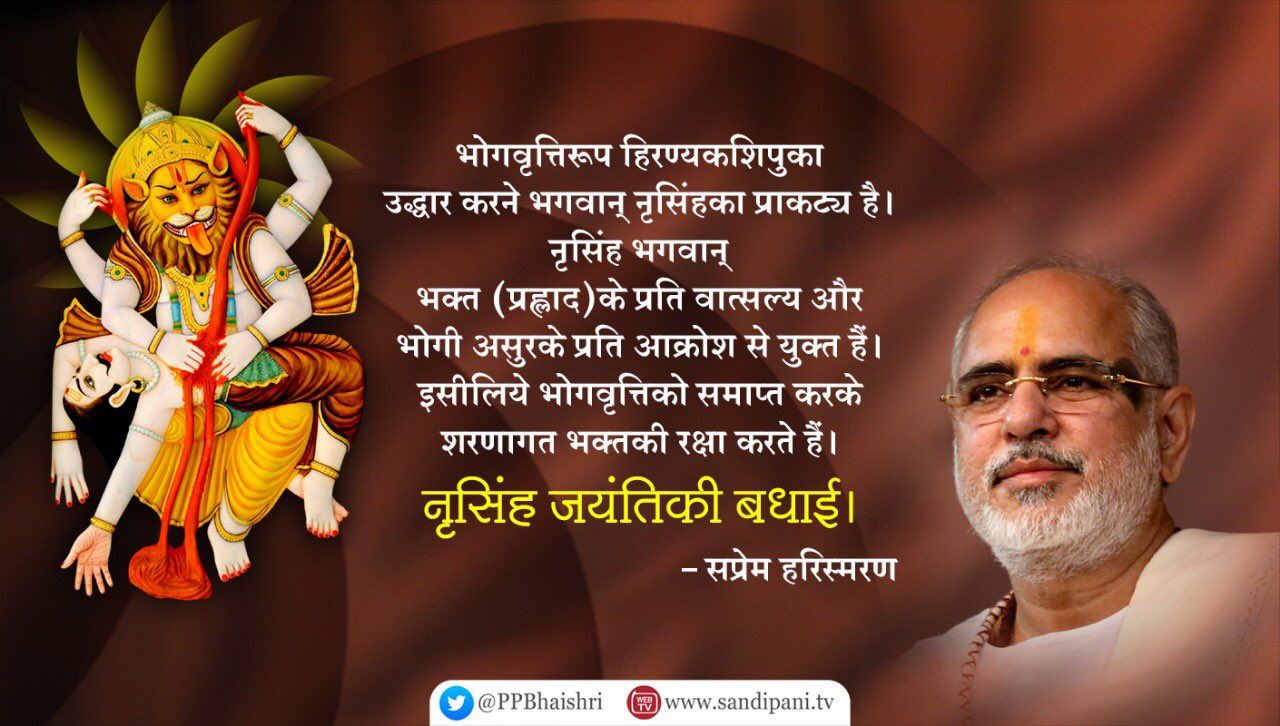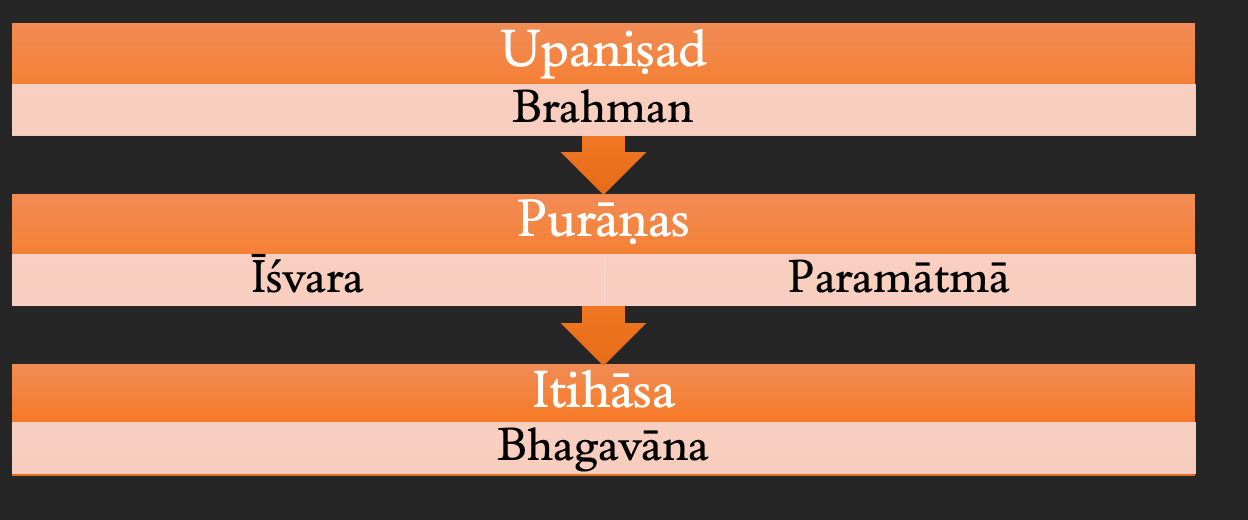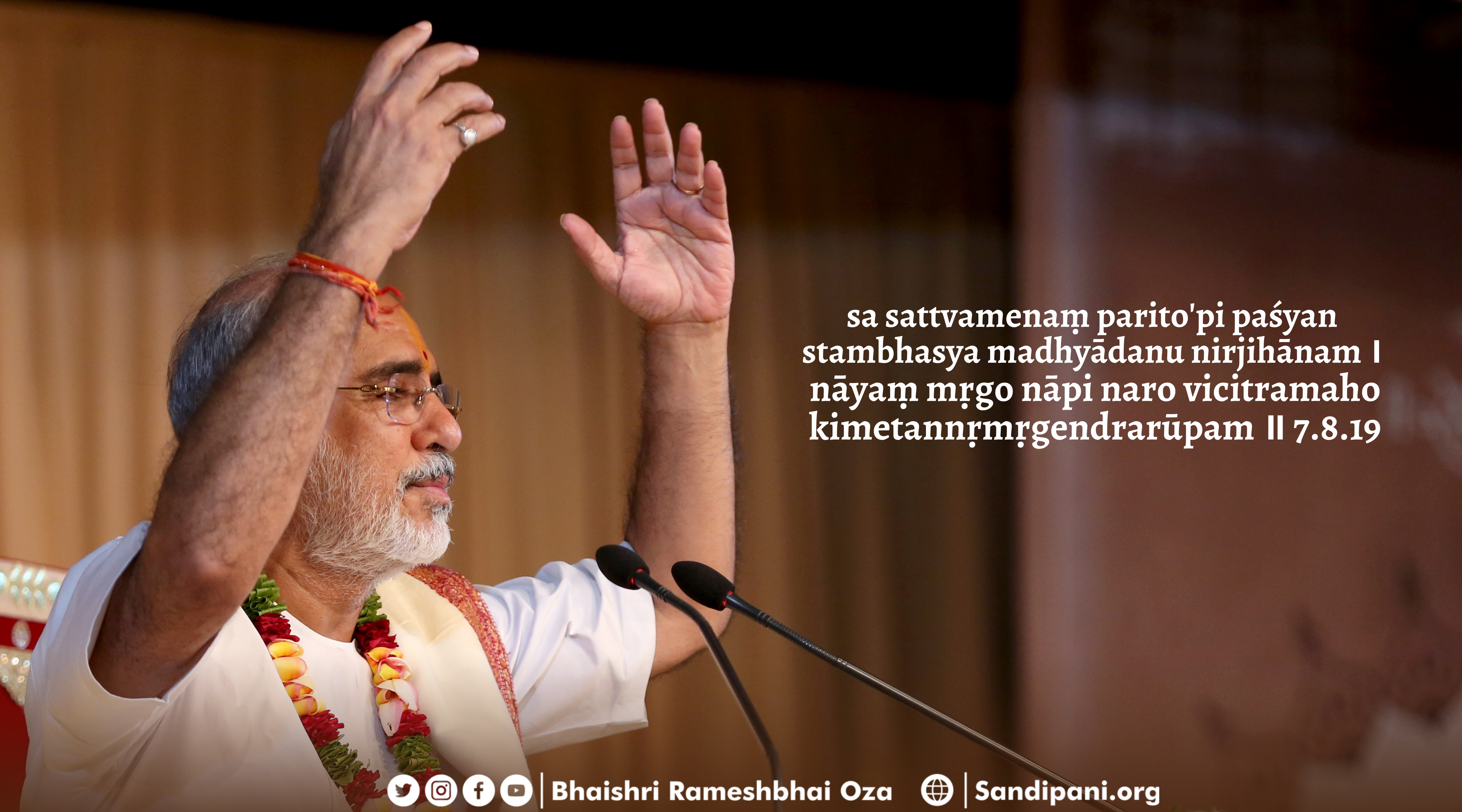The Causeless Grace of the Lord
– Shlok of the Week 15 – Shrimad Bhagavat – 7.8.19

‘Lord Nṛsiṃha appears to liberate ‘greed of indulgence’, personified by Hiraṇyakaśipu. Lord Nṛsiṃha is filled with parental love towards devotee Prahalāda and with fury towards demon, so he destroys the greed to indulge and protects the devotee in His refuge. Nṛsiṃha Jayantī salutations!’ @PPBhaishri
Who was Hiranyakashipu?
⚫ Hiraṇyākṣa & Hiraṇyakaśipu were Jaya-Vijaya (The Gatekeepers of the Lord) in his previous birth.
⚫ Hiraṇyākṣa and Hiraṇyakaśipu are ‘Ādi-Daitya’ (the first of the demons), hence their extraordinary strength and power.
⚫ Hiraṇyākṣa represents Saṃgraha-Vṛtti Lobha, whilst his brother Hiraṇyakaśipu represents Bhoga-Vṛtti Lobha. Lobha (Greed) is the father of all sins.
⚫ Hiraṇyakaśipu was the father of Prahalāda, who was a truly beloved devotee of the Lord.
The Demonic Forms Liberated Thrice
⚫ The four Sanatkumāras had cursed the Lord’s attendants, to fall from Vaikuṇṭha and to be reborn three times. The Lord had offered to take four Avatāras. In repentance, the four Sanatkumāras came in a combined Avatāra.
⚫ Hiraṇyakaśipu and Hiraṇyākṣa were born as the first demons, from Ṛṣi Kaśyapa and Diti. It was Diti who succumbed to her desire of improper union during an inauspicious period (Saṃdhyā). Hiraṇyākṣa was slayed by Varāha (3rd Skanda) and Hiraṇyakaśipu was slayed by Nṛsiṃha (7th Skanda).
⚫ The second advent, Rāvaṇa and Kumbhakaraṇa were born, who were slayed by Lord Rāma.
⚫ The third time, Dantavakra and Śiśupāla were born, who were slayed by Lord Kṛṣṇa.
Narasimha Bhagavan Manifestation
⚪ From the unmanifest to the manifest, from the subtle to the gross elements, the all-permeating Lord Viṣṇu was first experienced in the form of a fearsome sound (the quality of Ether).
⚪ Nṛsiṃha manifests in the form of half-lion and half-man, to make the words of His devotee true:
- Brahmāji, who granted the boon to Hiraṇyakaśipu (with the conditions under which he would not be killed);
- Sanatkumāras, who uttered the curse upon the Lord’s eternal attendants in Vaikuṇṭha (to be born in the demonic race thrice);
- Prahalādji, who affirmed that the Lord certainly existed in the pillar because the Lord is all-pervasive in the form of consciousness. This conviction (śraddhā) in the unseen but omnipresent Lord is what leads the omnipotent Lord to manifest.
⚪ Nṛsiṃha is only appeased by the bottomless devotion of his devotee Prahalāda, who had the perfect vision of equanimity. This can be found in the truly divine Prahlāda Stuti (ŚB – 7.8.40-56)
🔔 To Learn-More about Nṛsiṃha Avatāra:
Bhakt Prahalad
⚪ The Lord incarnates for the Sanatkumāras who have together accepted birth as Prahalāda and also for the upliftment of both demon brothers and sons of Dītī (Hiraṇyākṣa and Hiranyakaṣipu).
⚪ It is when his father Hiraṇyakaśipu, decides to severe the head of Prahalāda, that Nṛsiṃha Bhagavāna manifested out of the wooden tree.
⚪ Prahalāda appeases the Lord during this Stuti;
naite guṇā na guṇino mahadādayo ye
sarve manaḥ prabhṛtayaḥ sahadevamartyāḥ
ādyantavanta urugāya vidanti hi tvām
evaṃ vimṛśya sudhiyo viramanti śabdāt ŚB 7.9.49
🔔 Click to read more on Seven-Statements on Prahalāda Stuti:
⚪ When one understands that in fact nothing exists other than the Lord himself, there remain no-need to say anything!
⚪ The Lord manifests for the Love of His devotee Prahalāda and protects his from his father Hiraṇyakaśipu.
🔔 Click-Here to Learn-More about Bhakt Prahalāda:
3 Types of Vasanas
In the Seventh Skanda of the Śrīmad Bhāgavatam (Uti Līlā) which represents the right hand of the word-form Lord, contains 15 chapters that describe:
- The five dimensions of ‘false desires’ (Asad Vāsanā), the five chapters which are related to Hiraṇyakaśipu’s efforts for physical immortality.
- The five dimensions of ‘desire for the truth’ (Sad Vāsanā), in which five chapters depict the beloved devotee Prahalāda.
- The next five chapters depict‘mixed desires’ (Sadasada/Miśra Vāsanā) as possessed by Human Beings, which is also called the ‘Dharma Pañcādyāyi’ as taught by Devarṣi Nārada to Yudhiṣṭhira.

🔔 How do the qualities of our desires impel our actions? Click-here to learn more
2 Key Principles – Vedic and Bhakt Perspectives
The Vedic Perspective of Creation, which believes that all of existence is in fact consciousness (cetana), whereas the Bhakta Perspective believe that God exists in every atom, which underpins all of existence.
Concept of God
vadanti tattattvavidastattvaṃ yajjñānamadvayam
brahmeti paramātmeti bhagavāniti śabdyate
The learned know the ultimate non-dual truth to be called Brahman, Paramātmā and Bhagavāna
Śrīmad Bhāgavatam 1.2.11

According to Hindu literature, God can be categorised into three:
⚪ Brahman – The indivisible, attributeless spirit
⚪ Paramātmā/Īśvara – The creator, maintainer, and destroyer of material existence
⚪ Bhagavāna – The preserver of Dharma through incarnation
Register-Your-Interest for Sādhanā by clicking here

☀️ Did-You-Know?
The Lord incarnates for the Sanatkumaras who have together accepted birth as Prahalada and also for the upliftment of both demon brothers and sons of Dītī (Hiranyaksa and Hiranyakasipu)
🔔 Share your answer or a fun-fact in the comments section below……
About this Article
This is a part of an ongoing series to learn a Shlok a week from the Purushottam Maas Shrimad Bhagavat Katha by Pujya Bhaishri Rameshbhai Oza.
We hope devotees are able to savour a few fun facts on these verses with an enhanced interest for the context and divine nuances through this series.
This Article is the 15th in the ‘Shlok of the Week’ Series.
Series by
Rishi Harshitbhai Shukla;
Nimishaben Sadhu (India);
Rajeshbhai Purohit (UK).
#ShrimadBhagavat #Mahatmya #ShlokOfTheWeek #SVN_SOW #ScriptureOfLove